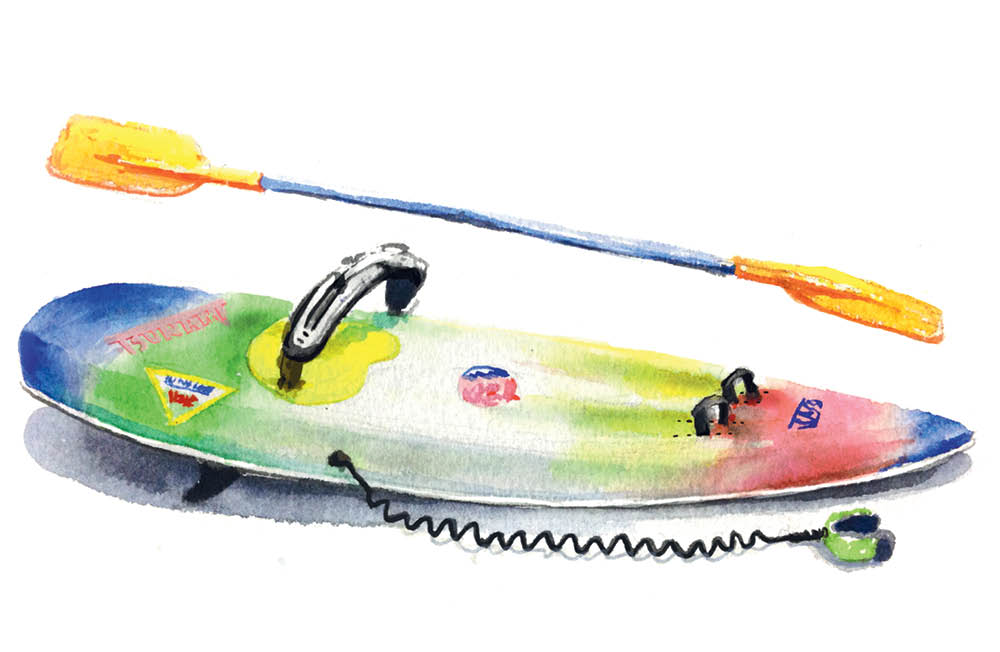The Short History Of Goat Boats
Share
As Malcolm keeps reminding us, ‘Strayans are innovators. We invented the Hills Hoist, the stump jump plough and the bionic ear. But that doesn’t mean we got away untainted. Kids, gather round: your father has something to tell you.
On the racks of a suburban SUV, a wave ski resembles a corn chip with a seat belt, or the love child of a surfboard and a luggage pod with fins. They broadcast a whole range of impressions to nearby road users that are best left uncommunicated.
The first wave ski was made around 1912 or ‘13 by Port Macquarie fisherman Harry McLaren, who used it to get around the oyster beds in Lake Innes. On weekends he’d take his craft out in the surf along with a guy named Doctor Crakanthorp. (No, he was not a giant squid. Concentrate please.)
At that stage, they were hollow timber and propelled with two small hand blades. Harry was fifteen when he made the craft, having previously surfed in his Uncle Ern’s duck hunting canoe near Pelican Island. Given these canoes were known as ‘duck punts’, you can see how close the wave ski came to having a crueller nickname than ‘goat boat’.
Crakanthorp brought the strange craft to Manly in about 1930. Photographs from the time indicate it had a nose leash attached to a belt on the rider – an early precursor to the idea of a legrope. It was Cracker (are we familiar enough yet to call him that? I think so…) who switched from two hand paddles to a single oar, thus ushering in the panic-stricken whirlwind stroke we all associate with a goat boat caught inside. The Doc also switched from kneeling to sitting and added footstraps. Otherwise, this could be a short history of kneeboarding.
Dr Backsacken also brought the craft to Maroubra, where it became very popular. These days, locals pointedly refer to it as Not Ours.
The Doc secured the Australian patent on the design and was therefore credited as its inventor. There appears to have been some ill will between him and Harry McLaren over this, even if it’s the equivalent of stealing the credit for importing cane toads.
In the ‘40s they grew wider and were ridden standing up, so this could have been a short history of SUPs. In return for the Duke giving us the gift of surfing, in the ‘40s we gave him a goat boat, which he rode at Waikiki until he was sure we were back on the plane.
So then there’s a lot of years in which the ski meandered down evolutionary paths – towards surf lifesaving where its true popularity lay, and into an esoteric backroad of surfing itself. Around 1967, American Olympic kayaker Merv Larson took the Australian design and made the quantum leap: a short, fibreglass ski with a seatbelt and without a fin (finless wave skis are still known as “Mervs”). Suddenly goatboaters were able to get in everyone’s way, in even the biggest of surf.
In the late seventies, Hayden Kenny, father of Grant, introduced the Australian wave ski to Hawaii, around the same time that the ever-inventive Shane Stedman started producing them under his “Shane” label. Over the summer of ‘84 he sold something like 300 of them. But summer ’85 was Peak Goat: the president of the NSW Wave Ski Surfing Association, a Mr Bernard Leslie, suggested in the Sydney Morning Herald that “Board riders have had a fair go – maybe it’s their time to go.”
According to the official rule book of the US Waveski Surfing Association, “Competitors must sit on top with bottom flush on seat.” Beautifully put, no?
In his 1984 autobiography Over and Out, the great D.K. Lillee included a photo of himself posing shirtless and gloriously hirsute in front of his car, with his wave ski. The caption: “My BMW, my ski, and me.” Why do I tell you this? Because it says something timeless about the relationship between moustaches and goat boats.
*If you want a proper history of these maligned craft, try surfresearch.com.
